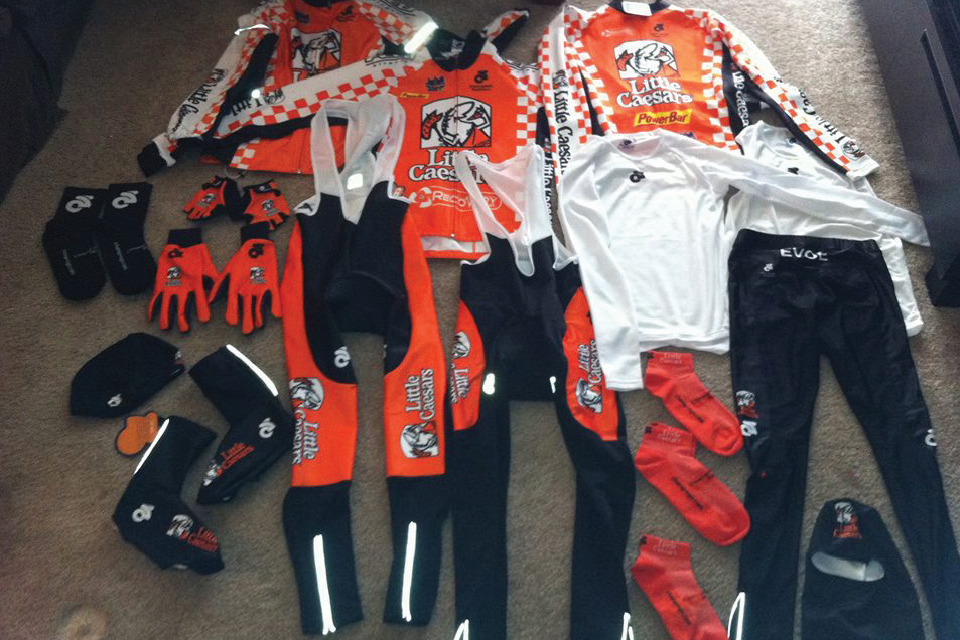Gear Up for Winter

The change of seasons is quickly approaching, bringing the cooler temperatures of the winter months. Having spent many mild winters in Austin and now a much colder one in Boulder, I've learned a lot more about training in the cooler months. Also, growing up in Michigan, I’ve had quite a bit more winter experience than the average Texan. Not everything I've picked up is 100 percent applicable to training in Austin's winters, but most of it can be adjusted to a milder climate.
Right gear and layers
First and most importantly, you need to have the right winter training gear for your climate. This doesn't mean you need the most expensive, just the most appropriate. When I moved to Boulder, I worked with my clothing sponsor to get a complete set of “bomb-proof” cycling and running gear so I could get outside in nearly all conditions. Growing up in northern climates, we learned early on that layering is important to staying warm. Always start with some form of base layer to wick the moisture away from the body. Then I wear the main insulation layer. This can be a single or multiple jerseys or shirts of differing thicknesses. Finally, depending on the conditions, comes the outer layer, usually a piece of clothing to help keep out wind and moisture, such as a wind-stopper vest or a full waterproof jacket. Another advantage to layering is that you can change what you're wearing as you're training. If you get too warm or the day heats up, you can always take a layer off.
Train later
I understand that many people don't have a great deal of flexibility with training time due to jobs and family. One big difference I've noticed between Boulder and Austin's winter training cultures is that in Austin, most people keep their summer early-morning meeting times for winter workouts, even on the weekends. In Boulder, cycling and running groups shift meeting times later to allow the day to heat up a little. If I want to train early in the winter, I take advantage of morning swim practice. Why not shift the weekend long run or bike ride a couple hours later to be more comfortable and enjoyable?
Feet, ears, hands
Your torso may be toasty warm, but if your feet, ears, and hands are cold, you'll be miserable. When getting dressed for that run or bike, pay special attention to those areas. Proper toe and shoe covers are critical for winter cycling. On the coldest days, I'll wear good skiing socks with my cycling shoes. Boulder cyclists have learned that high quality skiing gloves keep hands warmer than most cycling gloves when the mercury drops below freezing.
Learn your temperatures and conditions
I know exactly what I'm going to wear out biking or running in the winter by looking outside to see if there are clouds or sun and by knowing the temperature. Learn the same for your location and know your tolerances. It takes a little time and experimenting because everyone is different, but by being aware of how comfortable you feel during various sessions, it’s possible to fine tune future clothing choices.
Overdress/underdress
My motto: “I'd rather be 10 degrees overdressed than 10 degrees underdressed.” Too cold, and most are miserable and will probably quit the training session. Too warm, and sweating follows. In the summer, there’s no problem being warm and sweating, so what's the issue with sweating in the winter? Wet clothes can quickly bring down body temperatures.
Keep moving
If you do start sweating, don't stop moving. Movement keeps the body warm; as soon as it stops, sweat cools and body temperature drops fast. Once cold and wet, it's tough to get warm again. While running, make those water stops quick. When cycling, get moving again as fast as you can after water stops. I've been known to warm and dry my base layers on the hand driers in gas station bathrooms to prevent getting cold on pit stops during winter rides.
Longer warm-up
With the understanding that muscles don't get warm as quickly in the winter comes the need to take longer to warm-up in each session before pushing the pace. Running too fast with cold leg muscles is the fastest way to a pull or strain. This is why if I'm doing intensity while running or cycling, I'll take a long time to warm-up, and I'll almost always wear full tights to keep those muscles warm and supple.
Harden up
When winter comes around, especially in Boulder, I’ve learned that I have to get in the proper mindset. It's almost too obvious, but you need to convince yourself that it's winter and that means it’s going to be cold, just as you know that summer means you will be uncomfortably hot at times while training. If you're mentally prepared for the winter, you'll be much better off.
No place for macho
I remember turning up for winter bike rides in Austin where guys would make fun of someone they thought was overdressed for the weather. Wearing the least amount of clothing for the weather was all about the male ego. I never understood how wanting to be warm while cycling was somehow wimpy. I haven't seen this attitude in Boulder. I have training partners who are multiple Olympians and top ten in world rankings. They overdress, wear more layers, and have warmer clothing than anyone I've seen. It’s about being smart (and warm), not macho.






